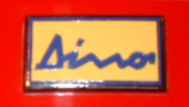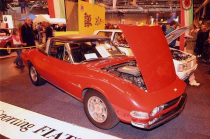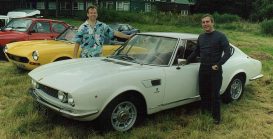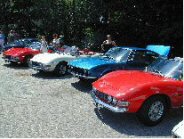Introduction
I remember my first time well.
It was a sunny summer’s afternoon in our local high street, I
was standing opposite a crossing when that unique muffled roar of a
Ferrari engine echoed off the shop fronts. I turned to see a dark blue
wonder! There are some car shapes that are bound to be forever classics
– and surely here was one. But this sports car bore none of the
expected badges. Yes, it was left hand drive, certainly Italian, but
as it departed, amidst more fabulous noises, did that rear badge say
Fiat Dino? I’d driven a Ferrari Dino but what was this?
Dino
History
Cooperation between Ferrari
and Fiat ran deeper than the car’s name. Ferrari required a smaller
capacity engine suitable for racing formulae and, so the story goes,
were going to struggle meeting the 500 examples of their V6 engine for
race homologation. Actually their "Dino" was intended to become
a separate marque for cheaper sports cars (other than Ferraris) and
they  never
carried Ferrari badges. The marque was named in memory of Enzo Ferrari’s
late son who was killed in a car accident. Ferrari proposed a Dino GT
while Fiat developed a Spider & Coupe. All powered by the Ferrari
V6 engine. So two lines of Dinos were produced.
never
carried Ferrari badges. The marque was named in memory of Enzo Ferrari’s
late son who was killed in a car accident. Ferrari proposed a Dino GT
while Fiat developed a Spider & Coupe. All powered by the Ferrari
V6 engine. So two lines of Dinos were produced.
By 1965 both companies had started development. First to appear was
the Ferrari Dino 206 S in 1966. 16 of these racers were built for the
GT & Prototype classes. They delivered around 218 hp @ 9000 rpm
and 268kph top speed. As well as providing initial engine testing, the
206 S also sported those image-boosting curves. Later that year the
Fiat Dino spider appeared, first introduced at the Turin motor show.
The Dino Spider was designed and built for Fiat by Pininfarina, who
also provided the bodywork for the Ferrari cars. Fiat awarded the task
of designing the Coupe to Bertone at the same time.
Series 1 Dino
Early Fiat Dino’s suffered from build quality criticisms. The
first series, hurried into production, had some reliability problems
(erratic oil pressure, sticking gearbox, plug fouling at low revs, fuel
line vapor-lock). In later series most of these problems were eliminated,
and are thoroughly understood in today‘s survivors. Fiat also
used a live rear axle design based on their 2300 S – with four
dampers. Though faster and cheaper in development, it limited the car's
potential and was replaced in the later 2400 Series 2.
Bertone’s Coupe had many luxury items we look for today, like
power windows, separately folding rear seats and automatic speed-dependent
rear window breathers. It’s wood finished dashboard is impressive.
Both Coupe and Spider interiors are finished in leather. The understated
Coupe is also deceptively larger. It outsold the Spider by about 4 to
1, despite being similarly priced. The Coupe is a genuine four seater
and this might account for its popularity. Most of the cars were sold
in Italy – where they remain today. No right hand drive examples
were factory made. The all aluminium Ferrari engine featured Dual Overhead
Cams per bank, 9 to 1 compression ratio and 3 Weber twin-choke carburetors.
The gearbox was a Ferrari 5 speed synchro, driving the rear wheels via
a limited slip differential. The front suspension was independent and
disc brakes were used on all 4 wheels with vacuum servo assistance.
Series 2 Dino
In 1969 revisions were introduced by Fiat. Their Dinos now boasted a
2.4 litre version of the V6 engine. The body shape and dimensions remained
similar, although many panels were reworked. The 2.4 litre spider is
hard to identify, most notable are the revised grill, ‘Dino 2400’
badges at the rear, and front indicator lights now behind the front
wheels, incorporating ‘Fiat Dino’ badges. The 2.4 litre
road wheels were all bolt-on - replacing the knock-on type.
The new engine was heavier
but more powerful and reliable. In the 2400 models the Ferrari transmission
was replaced by a more robust 5-speed ZF gearbox, and the rear suspension
was now fully independent with anti-roll bar.
The coupe interior was revised
with the instruments positioned around the driver with all dials fitted
into one panel. The bucket seats now featured headrests too. In comparison
the Spider dashboard remained straight-forward and a more classic layout
but was changed to a wooden fascia– replacing the original aluminium.
(The dashes are not really interchangeable). Overall the 2400 was much
refined.
End of the line – Glorious Failure?
In 1971 Fiat introduced the 130 coupe replacing the sporting Dino Coupe
with a larger grand tourer. Ferrari replaced the Dino 246 GT with the
rather squarer Dino 308 GT4. In the post oil crisis Seventies it was
Bertone’s mid engined design for the 308 GT4, and X1/9, and X1/20
(Lancia‘s Beta Montecarlo) that cultivated the distinctive flat
wedge bodies of the next era‘s Italian sports cars.
The Dino line stood for exciting yet affordable Italian thoroughbreds.
Their reliability and build issues hindered the early years. Still Fiat’s
Dinos deserve their present status alongside Ferrari’s 246 GT
because they have the enduring looks, excitement, power, and individuality
that make for a true thoroughbred classic.
Their heritage and direct descendants make it impossible for me to see
this joint venture as a failure. For Bertone, Fiat/ Lancia and Ferrari
were already collaborating to take this 2.4 litre V6 engine into another
very special car - the Lancia Stratos. Between ‘74 and ‘75,
500 of the Stratos Group B rally car were homologated. In competition,
it was a spectacular success, and rightly celebrated as a pinnacle of
Italian automotive innovation.
If it has to be seen as a commercial failure, the Dinos’ history
and the opportunity it affords us today to own one of these lovely machines
is nothing less than glorious.
Buying
Guide
The Fiat Dino 2.4 litre generally commands above 20% higher prices than
the earlier 2.0 litre – although many fewer 2.4 Spiders were made.
The Coupe’s prices are about half an equivalent Spider. In the
UK, auction prices for these cars have remained about the same for the
last 5 years – perhaps only the later Coupe prices having firmed
up.
Don’t expect to find one immediately here, you may have to travel
to find one. You’ll pay around £15,000 for a good 2.4 Dino
Spider (show room condition will be more). Look for a detailed history
file well populated with invoices. Like the 246 GT they had a reputation
for being stolen. Take along a specialist for the viewing.
Superperformance Ltd (superperformance.co.uk) parts lists are a ‘must
have’ for the would be owner. – acquire and study before
buying. Other UK specialists include Rosneath Engineering and Trentside
Classics. Don’t expect Ferrari dealers to have the knowledge or
interest for the Dino. Get talking and mailing to other owners.
Engine & Mechanical Notes:
Any engine re-builds are expensive, and from our band of regular owners,
is the most common reason for moving on. So don’t buy a smoky
or noisy engined one....
Has reputation for top end
lubrication problems – especially check cam/ valve wear
Exhaust replacement - it is a bespoke design and will cost £400/600
to have made
Later gearbox (ZF type) more reliable than the earlier Ferrari but expect
a notchy slowish selection, this is normal for both.
Expect many parts to need machining – not off the shelf!
Chassis and Engine numbers rarely matched at the factory!
Electrical Notes:
Relays and wiring is general dodgy (as with other Italian models of
this era)
Check loom esp around engine bay (Plan for a re-wiring?)
Early FIAT alternators are heavily taxed on the Dino – 77 amp
circuit – Parts are available.
Ignition system, check Distributor & Points wear. Consider modern
management system if not fitted
Check all the electric motors. Specialists in UK can re-build.
Check Coupe’s complex dash and automatic rear vent breathers –
unreliable.
Body Notes:
Even the youngest (last ones sold in ‘74) are now 30 years old.
Check the car’s poise – sits level? Drives with front &
rear wheels in line?
Check panel gaps esp. around doors & check for sagging from weakening
sills.
(note: Body flexure on Spider was always present if jacked at a front
corner & a door opened/ closed gently.)
Most affected rust areas are wings, floor, bottom ‘A’ post
& wheel arches, doors and jacking points.
Check all its flanks & inside of all steel panels for repairs. Body
parts are difficult to source, panels often unavailable.
Spider panels differ between the series 1 & 2 – beware
Plan for a rolling restoration… find a good and willing body/panel
beating shop.
Check spider hoods carefully - had tendency to leak... (check for stains
and floor rot under carpet – floor has no drain holes.)
Spider optional plastic hard top rare – expect to pay £500
to £1200 depending on condition.
Check for bumpers, body trim & badges – they are all expensive
& difficult to source.
Driving
Dino’s
In regular use the Dino needs to be treated with care. Some important
points:
Ensure the engine is at full operating temperature before applying high
revs or heavy strain
Use the electric system sparingly – keep energy consumption as
low as possible.
Strictly keep to the recommended oil types and oil changes
Its always difficult to objectively assess a thirty year old chassis.
What does today’s driver expect? How often and in what way would
you want to drive it? Even when new the motoring press commented on
the Dino’s lack of body rigidity – notably over bumps. Perhaps
its best compared with the 4.2 E type Jaguar of the same era. Both cars
are nervous in the wet, and have a unique smell and engine-borne attitude
when driving them. Their driving positions are basic but ok, clutch
action is a little heavy – nothing to worry about. Both are equally
at home in town traffic, motorways, or country roads – but neither
would match a contemporary Elan on the latter. The Dinos feel heavier
than a 124 of this age - and of course they are! The disc brakes are
adequate though.
The Series 2 Dino 2400’s independent rear suspension is noticeably
better. Exiting corners, the Dino will tend to sudden snap away under
power, even beyond normal for a rear wheel drive car. But the engine,
its response and note is unforgettable. Simply put, the Dino gives a
great sporting drive!
Types
of Dino
Dino
Numbers
Fiat continued to make Dinos as their top line car until 1972, the last
Dinos were listed and sold in ‘74. The majority were sold in Italy.
As the table below shows, Coupes outsold Spiders by about 4 to1. Only
424 of the larger engined Spiders were made. In contrast the larger
steel bodied Ferrari 246 quickly replaced the more expensive aluminium
bodied 206 GT and sold in much larger numbers. From 1972, Ferrari also
made a very successful spider version of the 246, the GTS.
|
Engine
|
Model |
Produced
|
Numbers
|
| 2 litre - |
Spider |
1967-69 |
1133 |
|
|
| |
Coupe |
1967-69 |
|
3629 |
|
| |
206 GT |
1967-69 |
|
|
152 |
| 2.4 litre - |
Spider |
1969-72 |
424 |
|
|
| |
Coupe |
1969-72 |
|
2414 |
|
| |
246 GT |
1969-74 |
|
|
2487 |
| |
246 GTS |
1972-74 |
|
|
1274 |
| |
|
Totals |
1557 |
6043 |
3913 |
| |
|
Dino
Model |
Spider |
Coupe |
206/246
GT |
Dino General Data:
|
Engine
|
|
Weight
(kg)
|
Top
Speed
(kph)
|
Power
(hp@rpm)
|
Fuel
Consumption
(mpg)
|
| 2.0 litre - |
Spider |
1150 |
210 |
160@7500 |
17.9 |
| |
Coupe |
1280 |
200 |
160@7500 |
19.0 |
| |
206GT |
990 |
235 |
180@8000 |
16.0 |
| 2.4 litre - |
Spider |
1240 |
210 |
180@6600 |
17.9 |
| |
Coupe |
1380 |
205 |
180@6600 |
19.0 |
SFC
Dino Gallery



Dino
Page Links
Spares
• Catalogue from Superformance
Ltd http://www.superformance.co.uk
who also specialise in 308s as well as the Fiat and Ferrari
Dinos. Based in Essex UK.
• Deep in the heart
of Detmold Germany is part of the Holtmann Niedergerke Group. For the
Fiat 124 130 and Dinos they carry excellent stocks of new reconditioned
and second hand spares. They should be on your shopping list. H&N
Online Shop they are in the process of extending the online spares
list here. Local Detmold retail outlet is Gettingman & Niedergerke
on +49 (0)5231/6179-0. They have more recently been extending their
ranges of badges and emblems to include the Dino range.
• Don't neglect the German
spares connections, as demand during the nineties has risen, the German
suppliers have sourced many parts out of Italy. Please keep me informed
if you find any more good ones!
Parts and Advice:
• Trentside Classics
http://www.trentsideclassics.co.uk
• Rosneath Engineering http://www.rosneathengineering.co.uk
• Searching through
cars for sale can give you some very good ideas - this is the sort of
Spider I'd really like to own! http://www.fiatdino.nl/reddino.htm
• An awful lot of guff
is talked about using unleaded fuel - and for early Ferrari engines
its the motoring equivalent of the millennium bug. Sort the ignition
timing out, ensuring detonation/ pinking is absent (perhaps add modern
engine management/ ignition modules for greater accuracy/ reliability).
If you use higher revs add octane booster, and then monitor valve seat
wear as normal. And read this from Puma Racing.... http://www.pumaracing.co.uk/unlead01.htm
Clubs and Enthusiasts:
• Thanks to the Fiat Dino Register of Holland - who had their
first meeting in June 2002 - for showing us some great shots of their
Dinos - their site is on http://www.fiatdino.nl
• If you want to practice
your German there's an owner's club site on http://www.fiat-dino.de
• No list like this
would be complete without a mention of Wally Clark who's built up the
US Fiat Dino Register. We have an email address for him at clarkinc@pacbell.net

